Table of Contents
ToggleIntroduction
The Asus A7A266(/-E) is probably the most common ALi MAGiK 1 based motherboard and also the only model released by a major company. The -E Version of the board (which we are taking a look upon today) features the final revision “C1" of the ALi MAGiK 1 chipset. This revision offers a substantial boost in performance over the previous chipset revisions. The first revision of the MAGiK 1 was a very poor performer, with performance (using DDR RAM) on the level (or even below) of VIA's KT133A SDR chipset.
The second (B0) revision was a vast improvement, but (to my knowledge) was only present on some boards that went to a few popular hardware websites like xbitlabs.com. But shortly after these news / reviews (which are dated around August of 2001), boards with the new “C1” revision already hit the retail shelves. The Asus A7A266-E's first release BIOS is dated to September 20th of 2001, so there is only a few weeks betwenn the B0 reviews and retail boards featuring the C1 revision of the chipset.
The A7A266 as well as the A7A266-E can be had with or without onboard audio, the only difference between the two variants is the revision of the northbrigde. The A7A266 has the poor performing A1 revision, the A7A266-E has the improved C1 revision.
Gallery
Specifications and Features
Chipset:
- ALi M1647 Northbridge Rev. C1 [MAGiK 1]
- ALi M1535D+ Southbridge [MAGiK 1]
CPU Support (with latest BIOS):
- Athlon Thunderbird (ALL)
- Athlon XP Palomino (ALL)
- Athlon XP Thoroughbred (all FSB266 models up to 2600+)
- Athlon XP Thorton (all FSB266 models up to 2400+)
- Duron Spitfire (ALL)
- Duron Morgan (ALL)
- Duron Applebred (ALL)
Memory Support:
- 2 DDR DIMM slots, up to 2 GB total
- 3 SDR DIMM slots, up to 3 GB total
- maximum module size for both memory types is 1 GB
- no simultaneous usage of SDR and DDR memory
Expansion Slots:
- 1x AGP Pro slot (1,5V) up to 4x
- 5x PCI slots
Connectors (internal):
- 2x IDE (UDMA133)
- 1x Floppy
- 4x USB 1.1
- Asus iPanel connector
- 3x 3-pin fan connectors total (1x CPU, 2x chassis)
Connectors (external):
- 2x PS/2
- 2x COM/RS-232
- 1x Parallel Port
- 2x USB 1.1
I consider the lack of an onboard audio solution as a plus, as I think far better solutions than the old onboard chipsets are readily available for little money. Very commonly recommended are the Creative Soundblaster Live! cards for example, which offer fantastic compatibility with our beloved old games and sound far better than any onboard solution of that era.
I also don't list (from a retro-gamers perspective) useless connectors and features like IR, Smartcard- or Wake-on-LAN connectors and so on.
Overclocking Features:
- Adjustable Multiplier (BIOS) from 5x to 13x (CPU with stock multiplier <= x13) (Jumper Free Mode) OR
- Adjustable Multiplier (BIOS) from 13x to 18x (CPU with stock multiplier > x13) (Jumper Free Mode) OR
- Adjustable Multiplier (DIP Switch) from 5x to 12,5x (Jumper Mode)
- Adjustable FSB (BIOS) from 100 to 166 MHz in 1 MHz steps (Jumper Free Mode) OR
- Adjustable FSB (DIP Switch): 90 / 100 / 101 / 120 / 126 / 133 MHz (Jumper Mode)
- Adjustable VCore (BIOS) from Standard V to 1,850 V in 0,025 V steps (Jumper Free Mode)
- DDR Voltage (Jumper): 2,50 / 2,60 V
The OC options of the A7A266-E are a bit confusing. First of all, the “Jumper Mode” is completely useless in my opinion. You only have multipliers of up to 12,5x available, everything else requires the “Jumper Free Mode” to be used anyway. Furthermore, there are very limited FSB options available and the VCore is not adjustable at all in “Jumper Mode”.
Secondly, the stock multiplier of the CPU determines, which multipliers are available for you to set. It is not possible to select a lower multiplier than x13, if your CPU has a stock multiplier of >= x13,5 and vice versa.


Next up are the voltage settings. In "Jumper Free Mode" you can adjust the VCore via BIOS. The lowest setting is the stock voltage of the CPU, the highest selectable voltage is 1,85 V. There is a "VID" jumper on the board, on which the manual states:

The thing is - this jumper doesn't do a thing. In “Jumper Free Mode”, there is no way to adjust the VCore, in “Jumper Free Mode”, the VCore is selectable in the same fashion as written above - the jumper changes nothing.
The next “useless” jumper is one, that does not even exist, according to the manual. Directly above the IDE connectors, there is a jumper called “JPCPU”. It is not mentioned in the manual and it does not appear in the boards overview picture:


Just like the VID Jumper, this one does nothing. The board behaves exactly the same, regardless of what this is set to. There are also no imprints on the board where settings for this jumper are mentioned.
The board offers an optional async FSB/memory divider of 3:4, if the FSB is set to 100-132 MHz. From 133 MHz and up there is only a 1:1 divider available. Unlike the IWill XP333(-R), the A7A266-E does not have a 1/5 divider to run keep PCI and AGP at their stock frequencies.


Documentation, Downloads, Drivers
Hardware and BIOS aside (for the moment) - the first big positive aspect when you chose a mainboard of a still existing manufacturer for your retro build, is, that you'll most likely won't have too much trouble finding documentation and BIOS files.
The support site for the A7A266-E can be found easily when you go to your search engine of choice and type "a7a266-e support".
Asus still offers the manual, the latest BIOS versions and even (audio) drivers for download. The chipset (/AGP) driver however, is only offered when selecting Win95. The downloadable version (1.90) is not the latest, but everything from version 1.82 and up is perfectly fine for this chipset.
Unfortunately Asus does not bundle a BIOS flash tool with the BIOS downloads and the utility is also not available for download in the BIOS & Firmware download section of the support page. The required "Aflash" utility can be found under Driver & Tools - there you have to select "Others" at the "Select OS" drop-down list:
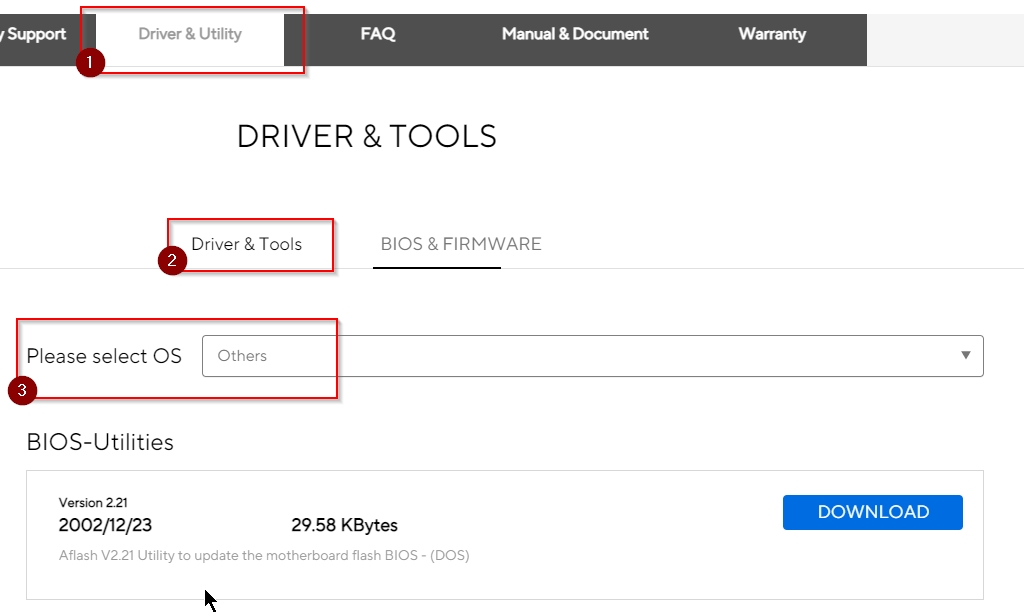
There is also a CPU support list directly on the A7A266's support page, where you can easily look up compatible CPUs.
On top of that, Asus also offers a global CPU Support search. Here you are not only able to search for a specific mainboard model but also the other way round: If you have an old CPU laying around, you can use the search form to find compatible mainboard models and maybe to get inspiration for your next retro build.
You can find it here: https://www.asus.com/support/cpu_support
Design & Layout
The overall layout of the A7A266-E is pretty solid and without major design flaws. The board features two DDR and three SDR memory slots, which all leave a generous space to the AGP port. For this reason, there is no problem installing or removing memory sticks while the graphics card is installed. The IDE connectors are located above the AGP port and sit nice and close to the edge of the PCB with the ATX power connector right behind them. This ensures that both the IDE cables and the ATX power cable can be easily routed away from the motherboard, to not have the airflow over the motherboard affected.


The Floppy connector is placed below the AGP port in a horizontal orientation. This is not perfect, but I've seen worse locations. Directly above the Floppy port, we have the CMOS battery socket, which gets covered a bit, if a very long AGP card is installed. But the CMOS battery can still be replaced without removing the videocard, so this is no big deal.
Moving over to the CPU socket, we find several capacitors in close proximity to both the left and right of the horizontally oriented CPU socket.
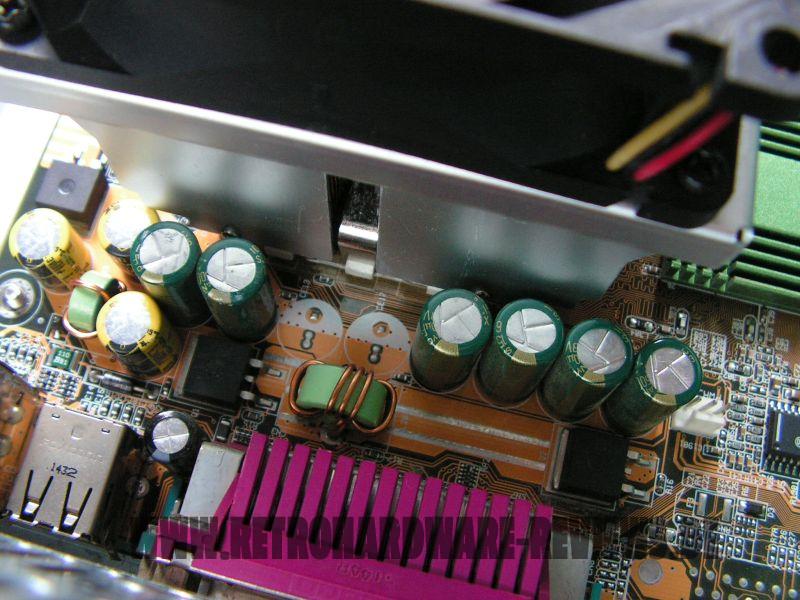

To find out how much of a problem this really is, I tested the following eight CPU coolers regarding compatibility:
- Thermaltake Silent Boost K7
- Cooler Master HHC-001
- Swiftech MCX 370
- Alpha PAL 6035
- Alpha PAL 8045
- Smartcooler 60mm
- Arctic Cooling Copper Lite
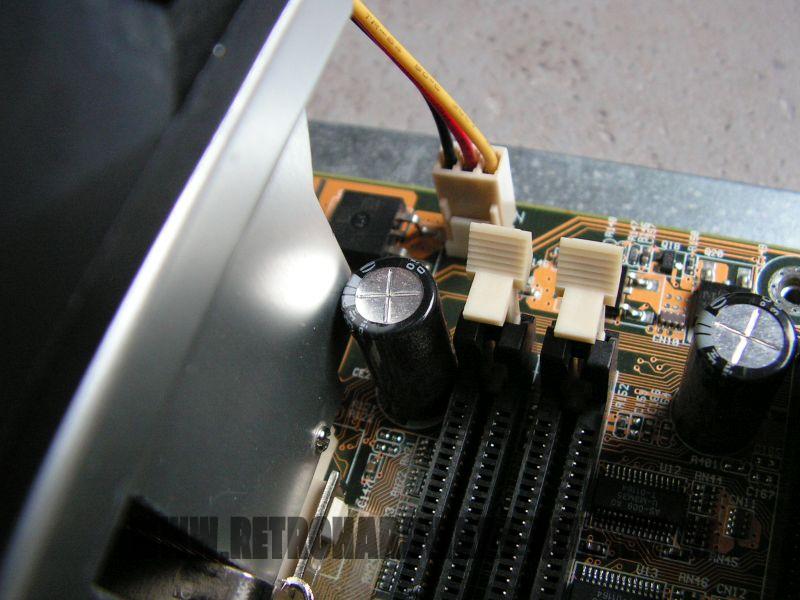
Out of these, all but one coolers installed fine. The only cooler that did not fit, is the massive Alpha PAL8045, which collides with the capacitor between the CPU socket and the DDR memory slots (as seen above with the Silent Boost K7 installed). The Thermaltake Silent Boost K7, as a representative of your average “big” CPU cooler is already a tight fit, it is certainly possible that there can be issues with the installation of CPU coolers of “the bigger kind”.


Our “problem childs”, the Cooler Master HHC-001 and the Arctic Copper Lite, are no problem to install, however. The caps to the left of the CPU socket are low enough to not collide with Arctic's cooler and the position of the CPU socket in general is ideal for the installation of the HHC-001.
Another good part of the A7A266-E's layout is the lower right corner, with several connectors, jumpers and the board's DIP switch easily accessible, even with long PCI expansion cards installed.

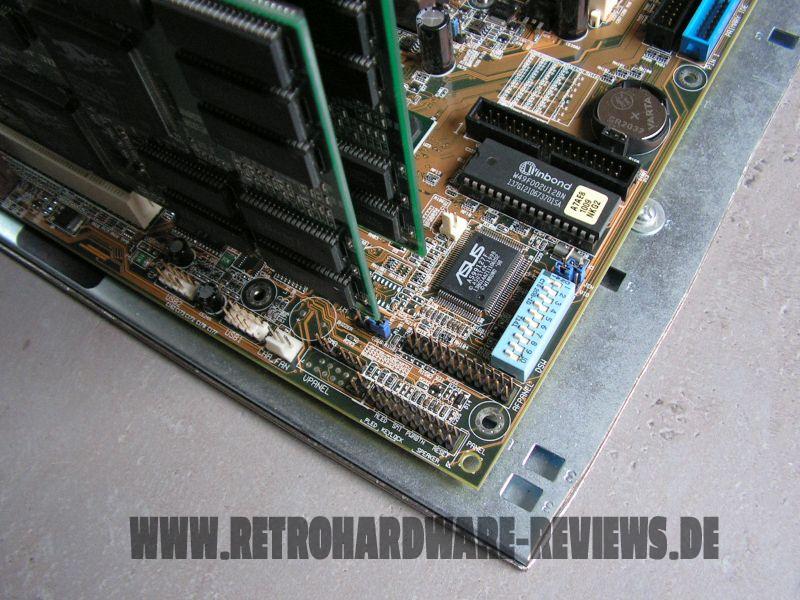
Aside of the frontpanel connector and the “JEN” jumper (for the activation of the “Jumper Free Mode”), there is also one of two casefan headers in this corner, which is a perfect spot for connecting a front fan. The second connector is located to the left of the northbridge, which also perfect for the connection of a rear fan.
Test-System and Parts
Baseline Setup:
- CPU: AMD Athlon Thunderbird 1200C (FSB133)
Because I want to compare 1st Gen Socket A mainboards to their DDR follow-ups I have to use a CPU, which is available in FSB100 and FSB133 versions with the same clockspeed. Since I sadly don't have a Thunderbird 1400 B at my disposal, I will use the Thunderbird 1200 for my reviews and comparisons of these boards, which I have in the “B” (FSB100) and “C” (FSB133) version.
- RAM (DDR): 1x Corsair CMX512-3200C2 (XMS3202v4.2) = 512MB PC400 CL2
This Corsair XMS stick should allow the tightest timings at 266 MHz DDR and its size of 512MB is the perfect choice for Windows 98SE
- RAM (SDR): 1x “Infineon 3rd” 512 MB PC133 SD-RAM
This memory stick has Qimonda chips rated at 7ns (=143 MHz). It runs flawlessly with the tightest timings at 133 MHz and its size of 512MB is the perfect choice for Windows 98SE.
- VGA: MSI Geforce 4 TI4200-VTD8X
To remove any GPU bottleneck for testing, I chose a Geforce 4 Ti as the primary graphics card for my test setups. The Geforce 4 Ti series are also known to pull a lot of power from the AGP port, so that possible problems in that department can also be revealed. It is also somewhat period correct and a good match for a high performance retro-machine that should be able to run late Windows 98SE games without any issues.
- VGA2: 3dfx Voodoo 5 5500 AGP
Many people consider the Voodoo 5 5500 the perfect card for (Win9x-) retro gaming. The Voodoo 5 benefits from a beefy setup, so a powerful Athlon Thunderbird or early Athlon XP is the perfect match for this card.
- Audio: Creative Soundblaster Live! (SB0060)
Creative's Soundblaster Live! can be found in many retro-machines. It offers great sound, perfect Win98SE compatibility and is still widely available for reasonable money. It was also known to cause problems with VIA-based 686B southbridges using old BIOS revisions and VIA chipset drivers. All this should be history at this point, but double checking on pontentially affected mainboards is still not a bad thing to do.
- LAN: 3Com Etherlink XL PCI
Just a good, reliable choice for networking. All legacy Windows versions all the way up from Win95 have built-in drivers for it, which is also a huge “plus”.
- HDD: Western Digital WD200BB (20GB 7200RPM)
No special intention behind this drive, it is just “there” and still works fine.
Additional Hardware for certain Tests:
- Silicon Image Sil3512 SATA Controller & Samsung PM871 128GB SSD
These two will help me measure the PCI bandwidth.
- Hitachi Deskstar T7K500 (500GB 7200RPM)
This drive will tell us, how big we can go with the onboard IDE connectors and how the performance is like.
- 2x Voodoo 2 12MB (SLI)
A pair of Voodoo 2s is a must have for any retro-machine, that doesn't feature a 3dfx card as the primary VGA solution. They offer compatibility to older Glide games and can be used with any more powerful primary graphics card. It is an important thing to know, how well these perform and if there are differences between all the available Socket A chipsets of that era or even between boards using the same chipset.
Drivers used:
- Chipset: ALi AGP 2.30
- Geforce 4: nVidia Forceware 43.45
- Voodoo 5: Amigamerlin 2.9
- Voodoo 2: FastVoodoo 4.6
- SB Live!: Some driver from my archive, not shure 😉
- 3Com NIC: Windows 98SE preloaded driver
- SATA Controller: Some driver from my archive, not shure 😉
System Setup and Usage
First of all, I want to mention something on the condition of my particular board. It arrived in an old system in shabby condition. Before I even tested it, I took the whole system apart and cleaned it. During that, I discovered two things.
First of all, there was an Athlon XP 2400+ installed in the system. As I found out later, the board arrived with a very old BIOS version (1009). The 2400+ is only supported from BIOS version 1012 and up - before that, the maximum supported multiplier should be 12,5x. Also, Athlon XPs are only supported from version 1010 and up, as the BIOS release notes for this version state “Add SSE function support of new AMD CPU”.
I wonder if it worked at all with this BIOS version, or if it was in there from a failed upgrade attempt (I didn't test the board with this CPU and its “original” BIOS version).
The latter would fit my second observation, as all five memory slots (DDR & SDR) were populated - which definitely doesn't work. The manual even warns, that the DDR sticks can be damaged if the board is powered up with both types of memory installed at the same time:

This is exactly what happened to this system. One DDR stick hat a burnt contact and the first DDR memory slot on this board also got damaged:
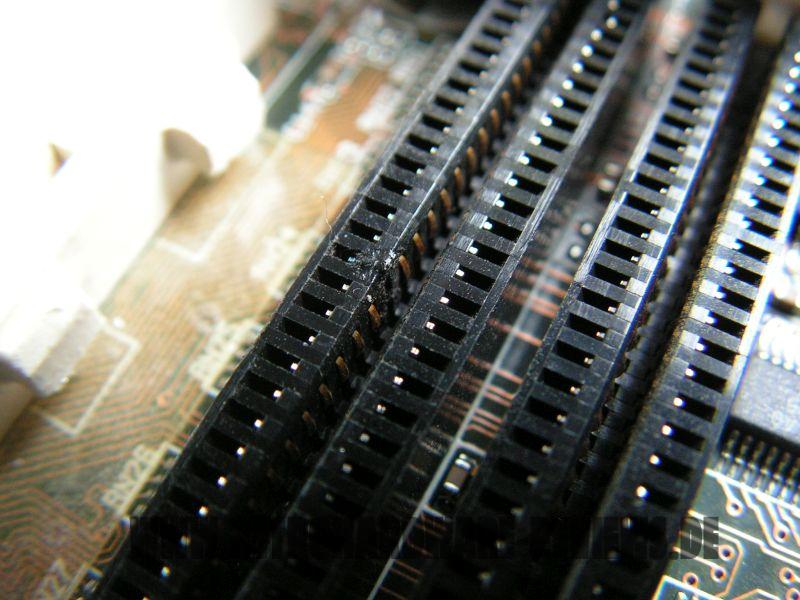
Luckily, the board itself still works and the one DDR slot remaining is sufficient for what this board is best used with (Windows 98). The SDR slots are fortunately undamaged as well.
Other than that, the whole review process was completely issue free and the board was easy to set up. When set to “Jumper Free Mode”, the board boots with 100 MHz FSB with any new CPU installed and takes you directly to the Advanced Settings page, where you can either select the CPU speed with 100 or 133 MHz FSB based on the detected multiplier, or configure all the settings manually. Under “Chip Configuration”, you are offered a good set of chipset and memory settings to tweak the board's performance. I configured the memory timings to CL2 2-2-6 (which were the fastest selectable timings, tRAS 5 was not selectable). These timings worked well with both SDR and DDR memory.
A great feature of the ALi MAGiK 1 is, that it offers 6 INT lines. This means, that IRQ sharing is something that can almost be completely avoided with this chipset. Asus did a great job exploiting this, as can be seen in the A7A266-E's INT routing table:

The only PCI slot with IRQ sharing is PCI #1, which is shared with the AGP port. This is perfectly fine, because this slot is best left free anyway, to leave some space to breathe for the graphics card. PCI #5 is shared with the onboard audio (if present), but since the chip can be disabled if a dedicated audio card is installed, this is no problem either. All other slots can be populated as you wish, even the USB controllers are connected to an INT line, that isn't used by any other PCI slot. This is a pretty intelligent design choice.
I installed the expansion cards as follows:
- PCI #1: free
- PCI #2: 3Com NIC
- PCI #3: SB Live!
- PCI #4: Voodoo 2
- PCI #5: Voodoo 2
The SATA controller was left out initially and got installed into PCI #5 when I was done benchmarking the Voodoo 2 cards. Like mentioned before, I did not face any problems during the installation or benchmarking process with this setup.
Benchmarks
Synthetic Measurements
Before we get into the 3DMark and gaming benchmarks, let's have a look at some theoretical numbers. These synthetic tests will exhibit the differences between the several chipsets and boards better than any game benchmark and provide us with "background information" that might be of use in understanding the timedemo results later.
Memory Performance: AIDA64 Cache & Memory Benchmark


The A7A266-E ranks fourth with DDR memory in terms of memory write throughput. Its read performance, however, is by far the lowest with this memory type. The SDR memory bandwidth is fairly identical among the three boards supporting it.
Its memory latency is higher than that of the SiS735 based K7S5A, but better than that of the VIA KT266-based AK32 for the respective memory types.
Application Performance: 7-Zip

The Asus board shows a very strong performance in the 7-Zip benchmark, taking second (DDR) and fourth (SDR) place. The result for the SDR memory is especially impressive, as it can beat the AK32 and the XP333-R, both using DDR memory. Furthermore, the performance hit with the slower memory is very small, as opposed to the K7S5A.
AGP Performance: Final Reality Benchmark
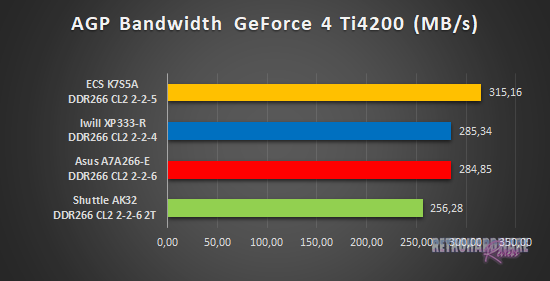

The AGP throughput for both videocards is almost identical to the other ALi board in the test, namely the IWill XP333-R. The bandwidth for the GeForce 4 Ti is on the level of the XP333-R and ranks between the very well performing K7S5A and the KT266 based AK32.
The bandwidth for the Voodoo 5 looks not particularly good for both ALi boards. We'll see later, if this is a limiting factor in one or more of our 3D(-gaming) benchmarks.
AGP and PCI Performance: 3DMark 2000 and ATTO
3DMark 2000 as a whole is very focused on TnL and is by far not as interesting for retro-hardware comparisons as its predecessor. Its “High Polygon Count, 1 Light” test, however, is another good way to measure the AGP performance. In opposite to the Final Reality test, the general system performance is also somewhat of importance. The benchmark was executed with the Geforce 4 Ti installed.
To measure PCI performance, I installed a Windows 98SE compatible SATA controller with a Samsung PM871 128GB SSD connected into the system. For the bench, I chose 1024 to 4096 KB block size and picked the overall best values for the read and write throughput. This test will show, which maximum performance can be expected with fast storage options like SATA or SCSI and maybe gives a hint, if the chipset might be good for Voodoo 2 cards.


The Asus board takes last place in the 3DMark2000 sub-test, scoring more than 15 % lower than the first-placed K7S5A.
The PCI read throughput in the ATTO test is quite good with just under 88 MB/s. The write performance, on the other hand, is very poor, with only 42,1 MB/s.
Storage Performance: HDTach
To measure the performance of the board's IDE and (if available) onboard IDE RAID solutions' performance, I benched one of the latest and fastest IDE drives (the Hitachi Deskstar T7K500 500GB) with the HDTach benchmark. I also tried a much more “recent” drive (the Western Digital Blue Edition 500GB), which should be even faster in theory, but the Hitachi drive produced much better results in this test.


The IDE performance is very close between the boards and generally on a very high level. Both ALi based boards achieve an identical result of 77,9 MB/s and rank third.
Gaming Benchmarks
Now that we got all the theoretical performance numbers, let's see how the contenders perform in 3D gaming benchmarks.
3D Performance: 3DMark99max
3DMark99max was released in early 1999 and comes without support for Hardware TnL. The maximum supported (hardware-) DirectX level is DX6. It is a great benchmark to reveal good overall system performance, as it rewards good memory bandwidth and latency more than the slight clockspeed advantage, that some boards have because of their factory-overclocked FSBs.
- Version: "latest"
- Settings: standard


In the GeForce 4 Ti run of 3DMark99max, the A7A266-E takes third place, with a small lead over the second ALi board in test. It is the fastest board with SDR memory in this run, more than 200 points ahead of the other two SDR memory results.
The results for the Voodoo 5 run look similar at first, at least when looking at just the first 4 ranks. Upon closer inspection, we see that the second-place K7S5A has more than doubled the gap between it and the Asus board. Moreover, there are only just over 250 points between the A7A266-E and the SDR memory result of the K7S5A. This is definitely due to the very different AGP bandwidths that the boards showed in the Final Reality Test, where the Asus board (along with the XP333-R) showed the lowest bandwidth and the Elitegroup board the best.


The "performance" in the Voodoo 2 SLI run of 3DMark99max is on the same catastrophic level as on the second ALi board. It seems like this chipset is best not combined with Voodoo 2 cards.
The numbers for the CPU Marks look good. The Asus board is second only to the XP333-R with the overclocked FSB of 172 MHz, its result using SDR memory is also the best for this type of memory and even higher than the AK32's with DDR memory.
3D Performance: Unreal Tournament (UT99) Timedemo(s)
Unreal Tournament (UT99) was released in November 1999 and is notorious for its hunger for CPU power. I chose to use two different timedemos for comparison, of which the utbench.dem timedemo is heavily CPU bound and therefore qualifies to measure the general performance of the boards. The second timedemo benchmark.dem is as GPU limited as possible in this game. This will reveal, how much impact a faster board can still have in more GPU limited situations. This game is also perfect to show, on which chipsets and boards Voodoo 2 cards run best.
- Version: 4.36
- Settings: High, Min desired Framerate "0", Show Decals [x], Use Dynamic Lightning [x]
- Geforce: D3D
- Voodoo 2 and Voodoo 5: Glide


Using DDR memory, the boards' performance in the GeForce 4 Ti run of the UT benchmarks is very close to that of the K7S5A in both timedemos. In the benchmark.dem timedemo, the average framerate of both boards is essentially identical, but the ECS board has an advantage of 0,9 FPS in minimum FPS.
With SDR memory, the Asus board is the faster of both and essentially matches (or surpasses, in terms of min. FPS in the second timedemo) the Shuttle AK32's DDR memory performance.
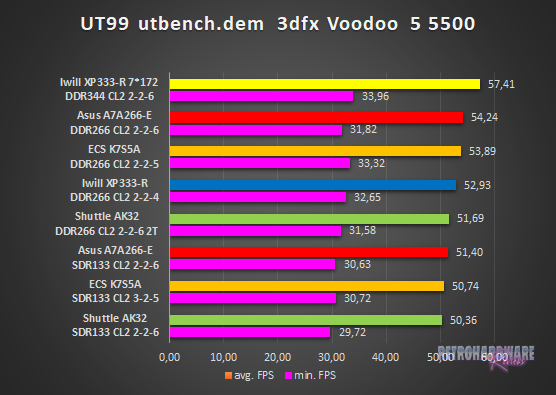

In the utbench timedemo, the A7A266-E's ranks second, closely in front of the K7S5A. However, its minimum FPS are significantly lower than those of the boards surrounding it and more in the range of the AK32, which ranks fifth.
In the second timedemo, it takes third place, between the K7S5A and the XP333-R.
Its performance with SDR memory is again the strongest of the three boards using this type of memory.

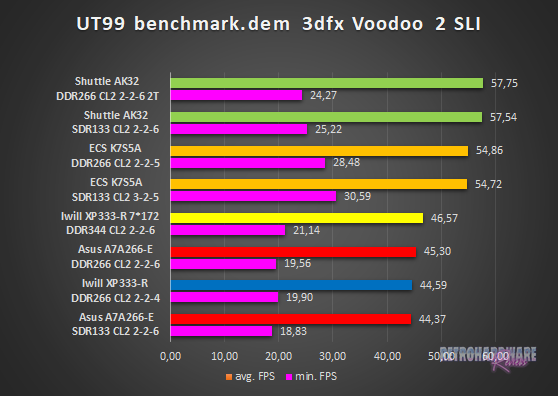
We see the same catastrophic result for the Voodoo 2 cards as in 3DMark99max before - both ALi boards show abysmal performance and battle for last place.
3D Performance: Quake III Arena Timedemo
Quake 3 Arena was released shortly after Unreal Tournament, in December of 1999. It is known to reward fast memory latency and with its normal preset, it is completely CPU limited; at least for the GeForce 4 and the Voodoo 5. The Voodoo 2 SLI cards clearly limit the Athlon 1200 here, as the timedemo will show.
- Version: 1.32
- Settings: “Normal” Preset, only resolution changed to 1024x768x16
- Geforce 5 and Voodoo5: OpenGL
- Voodoo 2: “Voodoo” Renderer (miniGL)

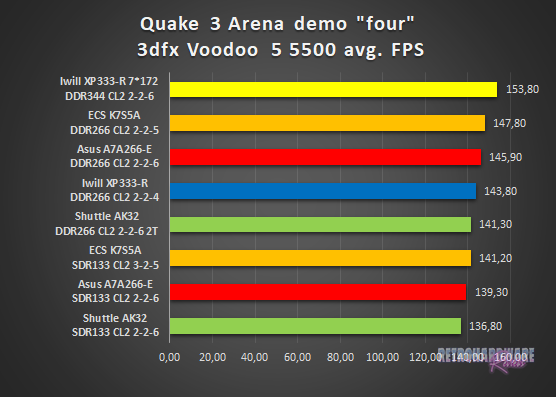
The A7A266-E takes third (DDR) and fourth (SDR) place in Quake III Arena, with especially the latter being a phenomenal result. The Asus board equipped with SDR memory can beat IWill's XP333-R as well as the Shuttle AK32, with both of them using DDR memory. This makes it by far the fastest board with SDR memory in the test. The difference in performance between the two memory types is sensationally low on the Asus board.
In the Voodoo 5 run, it also takes third place, right between the K7S5A in second place and the XP333-R right behind it. The result with the SDR memory is a little lower this time, in close competition with the other two boards with this memory, ranking second to last.
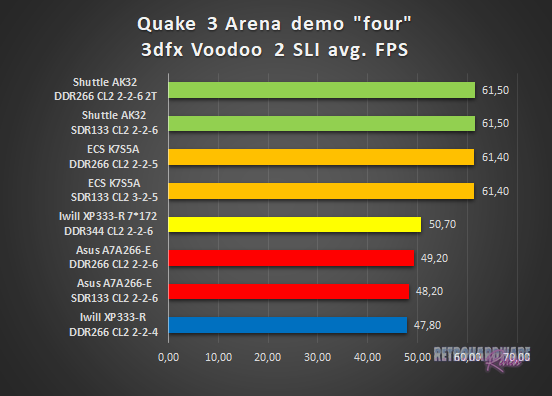
Both ALi boards again show poor performance, far worse than seen from the VIA and SiS chipset-based boards by Shuttle and ECS. The A7A266-E ranks second- and third last, between the XP333-R's results for stock and overclocked FSB.
Summary & Rating
Asus A7A266-E (ALi MAGiK 1)
-
Layout
-
Features
-
Overclocking Options
-
Compatibility
-
Documentation & Support
-
Performance: GeForce 4 Ti 4200
-
Performance: Voodoo 5 5500
-
Performance: Voodoo 2 SLI
OVERALL
| Pros | Cons |
| + Great layout | – Bad PCI performance |
| + Great CPU support and memory compatibility | – Abysmal Voodoo 2 performance |
| + Great IRQ management | |
| + Very fast with SDR memory |





